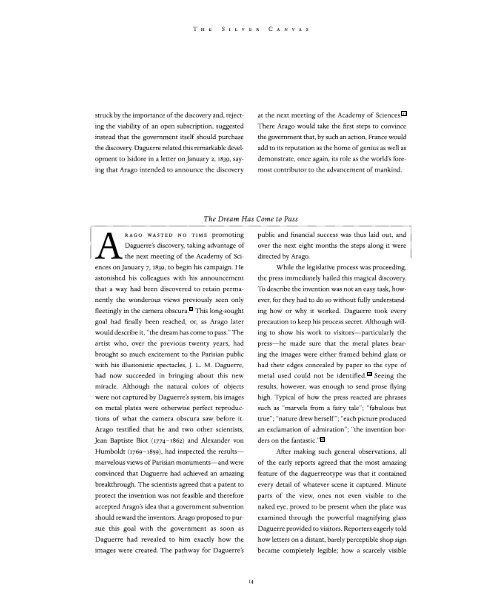The Silver Canvas - Daguerrotype Masterpieces (Art Photography Ebook)
You also want an ePaper? Increase the reach of your titles
YUMPU automatically turns print PDFs into web optimized ePapers that Google loves.
T H E S I L V E R C A N V A S<br />
struck by the importance of the discovery and, rejecting<br />
the viability of an open subscription, suggested<br />
instead that the government itself should purchase<br />
the discovery. Daguerre related this remarkable development<br />
to Isidore in a letter on January 2, 1839, saying<br />
that Arago intended to announce the discovery<br />
at the next meeting of the Academy of Sciences. 37<br />
<strong>The</strong>re Arago would take the first steps to convince<br />
the government that, by such an action, France would<br />
add to its reputation as the home of genius as well as<br />
demonstrate, once again, its role as the world s foremost<br />
contributor to the advancement of mankind.<br />
<strong>The</strong> Dream Has Come to Pass<br />
ARAGO WASTED NO TIME promoting<br />
Daguerre s discovery, taking advantage of<br />
h. the next meeting of the Academy of Sciences<br />
on January 7, 1839, to begin his campaign. He<br />
astonished his colleagues with his announcement<br />
that a way had been discovered to retain permanently<br />
the wonderous views previously seen only<br />
fleetingly in the camera obscura. 38 This long-sought<br />
goal had finally been reached, or, as Arago later<br />
would describe it, "the dream has come to pass." <strong>The</strong><br />
artist who, over the previous twenty years, had<br />
brought so much excitement to the Parisian public<br />
with his illusionistic spectacles, J. L. M. Daguerre,<br />
had now succeeded in bringing about this new<br />
miracle. Although the natural colors of objects<br />
were not captured by Daguerre's system, his images<br />
on metal plates were otherwise perfect reproductions<br />
of what the camera obscura saw before it.<br />
Arago testified that he and two other scientists,<br />
Jean Baptiste Biot (1774-1862) and Alexander von<br />
Humboldt (1769-1859), had inspected the results—<br />
marvelous views of Parisian monuments—and were<br />
convinced that Daguerre had achieved an amazing<br />
breakthrough. <strong>The</strong> scientists agreed that a patent to<br />
protect the invention was not feasible and therefore<br />
accepted Arago s idea that a government subvention<br />
should reward the inventors. Arago proposed to pursue<br />
this goal with the government as soon as<br />
Daguerre had revealed to him exactly how the<br />
images were created. <strong>The</strong> pathway for Daguerre s<br />
public and financial success was thus laid out, and<br />
over the next eight months the steps along it were<br />
directed by Arago.<br />
While the legislative process was proceeding,<br />
the press immediately hailed this magical discovery.<br />
To describe the invention was not an easy task, however,<br />
for they had to do so without fully understanding<br />
how or why it worked. Daguerre took every<br />
precaution to keep his process secret. Although willing<br />
to show his work to visitors—particularly the<br />
press—he made sure that the metal plates bearing<br />
the images were either framed behind glass or<br />
had their edges concealed by paper so the type of<br />
metal used could not be identified. 39 Seeing the<br />
results, however, was enough to send prose flying<br />
high. Typical of how the press reacted are phrases<br />
such as "marvels from a fairy tale"; "fabulous but<br />
true"; "nature drew herself"; "each picture produced<br />
an exclamation of admiration"; "the invention borders<br />
on the fantastic." 40<br />
After making such general observations, all<br />
of the early reports agreed that the most amazing<br />
feature of the daguerreotype was that it contained<br />
every detail of whatever scene it captured. Minute<br />
parts of the view, ones not even visible to the<br />
naked eye, proved to be present when the plate was<br />
examined through the powerful magnifying glass<br />
Daguerre provided to visitors. Reporters eagerly told<br />
how letters on a distant, barely perceptible shop sign<br />
became completely legible; how a scarcely visible<br />
14


